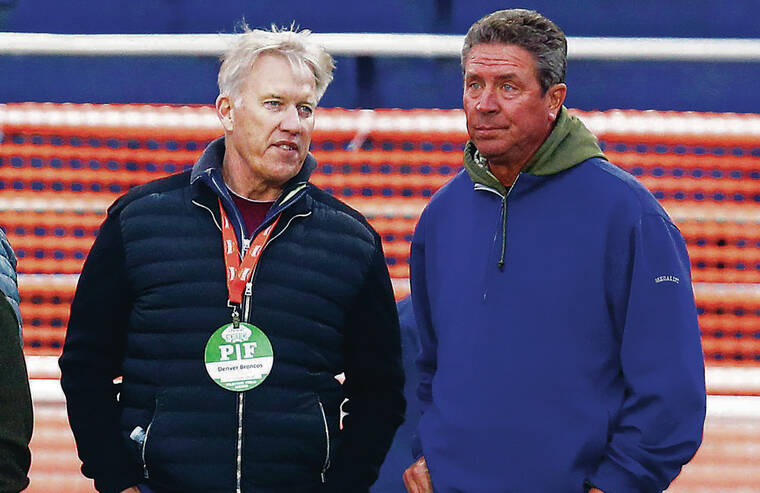
We’ve been down this path before.
Well, sort of.
A record-tying six quarterbacks were selected in the first round of the NFL Draft, matching 1983, which was known as the Year of the Quarterback. But this time the six went in the first 12 picks, compared to the first 27 in ’83.
As expected by most, Caleb Williams (Bears), Jayden Daniels (Commanders) and Drake Maye (Patriots) went 1-2-3. Then, in a surprise move, the Falcons — who recently signed Kirk Cousins to a big contract — traded up to get Michael Penix Jr. at No. 8. That was followed by the Vikings getting J.J. McCarthy at No. 10, and Bo Nix going 12th to the Broncos.
Speaking of Broncos, in ’83, John Elway was the first pick — by the Baltimore Colts, for whom he never played a down. He’d warned them, but they picked him anyway. Using the idea of playing pro baseball instead of football as leverage, Elway forced a trade and ended up in Denver, Super Bowls and the Hall of Fame..
The next QB wasn’t picked until No. 7, by the Chiefs. Remember Todd Blackledge? If you do it’s probably more as a broadcaster than as an NFL quarterback.
Then, at 14 and 15 came two more familiar names, Jim Kelly and Tony Eason, to the Bills and Patriots.
Ken O’Brien went to the Jets at No. 24 — and finally, at No. 27, the steal of the draft, Dan Marino to the Dolphins. Marino didn’t win a Super Bowl for Miami, but he did just about everything else in one of the greatest NFL careers ever.
The idea of Marino not getting picked until the second-to-last pick of the first round is of course absurd. And it’s not Monday morning quarterbacking to say so.
Marino’s talent was unquestioned coming out of Pitt, where he started from his freshman year and the Panthers posted three consecutive 11-1 records. But his draft stock dropped due to a lackluster senior year.
In 1983, players with remaining eligibility were not yet eligible for the draft. If they had been, it’s anybody’s guess where Marino would’ve ended up in the 1982 Draft, coming off an MVP performance in a Sugar Bowl victory over Georgia and Herschel Walker. Art Schlichter and Jim McMahon were the only first-round quarterbacks picked in ’82, at No. 4 by the Colts and No. 5 by the Bears. No wonder the Colts were desperate for Elway just a year later.
Since 1990, when the rules changed, it became common for underclassmen to go pro. But now, with the NIL rules allowing players to get paid while playing in college there’s more incentive to remain a so-called amateur.
Plus, this crop of quarterbacks had an extra year of eligibility because of the pandemic.
This means more of the top quarterback prospects have more game experience than others of recent years. Playing experience is widely considered a positive for quarterbacks by NFL scouts and decision-makers. They’re older, but that also means they’re wiser.
In ’83, those four-year players had plenty of experience, but it didn’t mean they were expected to start right away as often as most are now.
In contrast to quarterbacks, the first running back wasn’t picked this year until Texas’ Jonathan Brooks at No. 46 to the Panthers.
It’s hard to pinpoint exactly when the golden age of the running back ended. It seems like it was a gradual thing.
Reggie Bush was the last running back to win the Heisman Trophy, way back in 2005. He had it taken away in 2010 (since returned) for receiving what was then considered improper benefits — yeah, what would be known now as NIL, and perfectly legit.
I think back to the 2015 Super Bowl when the Seahawks didn’t give the ball to Marshawn Lynch at the 1-yard line for a game-winning touchdown, instead gift-wrapping another Lombardi Trophy for the Patriots with an ill-advised pass that was intercepted. The fact that a play call like that could even be considered said a lot about how the value of running backs vs. quarterbacks had changed.
Pro-style offense means something quite different than it did just a few years ago, and it shouldn’t be a surprise that QBs were picked earlier and more often than ever before. It’s finally fully accepted that your chances of winning are better with a quarterback who can run.
If football is chess, the quarterback is now considered the king AND the queen. He’s the piece that is your most potent weapon, and also the one you must protect at all costs.
And who is the QB’s most important bodyguard? You know this, it’s Football 101; the offensive tackles, the agile behemoths who keep those quick and ferocious edge rushers at bay.
Even more offensive tackles (eight) than quarterbacks were picked in the first round.
It’s true that quarterbacks are more athletic, and entering the league with more experience than ever before. But they still can’t throw or run for touchdowns with their backs on the ground.
Read More: World News | Entertainment News | Celeb News
Star Ads





